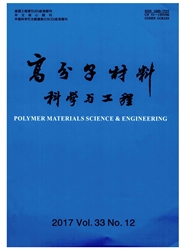

 中文摘要:
中文摘要:
以二氧化碳脉冲等离子体处理方法在聚乙烯表面引入羧基,合成了端阳离子的聚乙二醇重氮树脂,再用静电自组装并辅以UV辐照的方法,在羧化聚乙烯表面引入共价键连接的聚乙二醇分子链。用红外光谱(FT-IR)、扫描电镜(SEM)、紫外-可见分光光度及接触角测试等方法对改性表面进行了表征。结果表明,10W、5min及占空比(τon/τoff,μs)200/300的脉冲等离子体处理条件既可在聚乙烯表面有效地引入羧基,同时表面刻蚀作用轻微。UV辐照后改性表面连接的聚乙二醇分子链可耐N,N-二甲基甲酰胺(DMF)-ZnCl2-H2O三元极性溶剂的刻蚀。聚乙烯表面的水接触角从104°降低到了改性后的51.4°,获得了亲水性。
 英文摘要:
英文摘要:
Hydrophilic polyethylene glycol(PEG)chains were introduced on the carboxylated HDPE surface derived from CO2 pulsed plasma treatments by the electrostatic self-assembly method with PEG diazo-resin as the polycation. A transition of electrovalent linkage to covalent linkage in the self-assembled monolayer was achieved by exposing the modified surface under UV irradiation. The decomposition dynamics of diazo groups was determined by UV-visible spectroscopy method,and the modified HDPE surfaces were characterize by Fourier transform infrared spectrum(FT-IR) ,scanning electron microscope (SEM) and contact angle measurements. A moderate pulsed plasma condition at the peak power 10 W,the treatment time 5 min and the duty cycle (τon/τoff,μs) of 200/300 was adopted,under which carboxyl anions were steadily introduced on HDPE surface and with only slight surface etching. The covalently stabilized PEG monolayers were confirmed to resist the polar solvent corrosion by N,N-dimethylformamide (DMF)-ZnCL2-H2O. Water contact angle of the modified HDPE surface was decreased to 51.4° from 104° of the HDPE substrate surface.
 同期刊论文项目
同期刊论文项目
 同项目期刊论文
同项目期刊论文
 期刊信息
期刊信息
